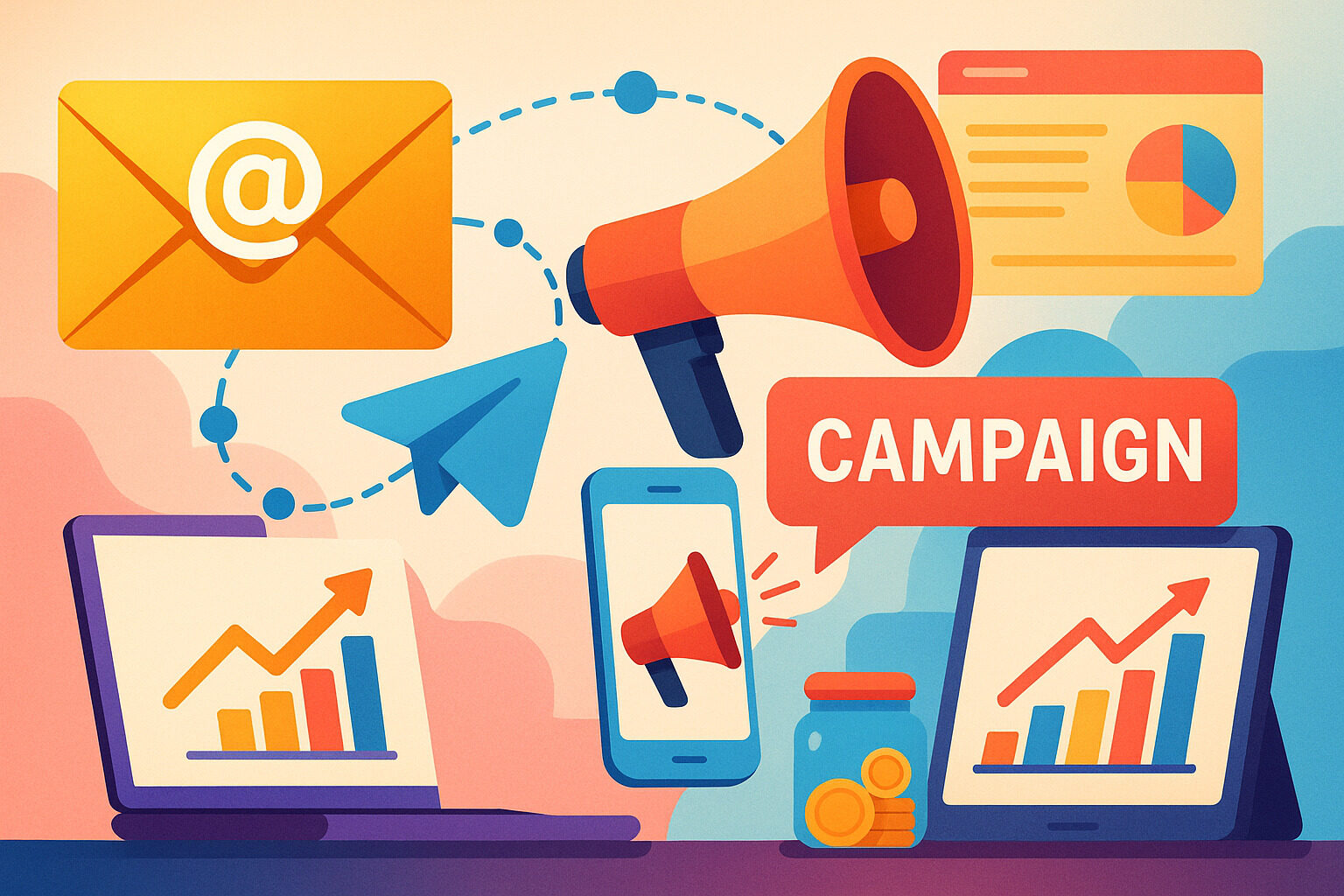Building a Reliable Communication Flow Across Two Channels
Campaigns thrive on attention and trust. Email has long served as the backbone of digital marketing due to its ability to deliver rich, trackable content. Telegram, on the other hand, adds immediacy, reach, and casualness that feels more personal. Bringing both into the same strategy creates balance—structured delivery from email and spontaneous conversation from Telegram.
Many brands find that while emails carry detailed content like product launches or newsletters, Telegram is effective for brief nudges, limited-time offers, or reminders. A brand can use Telegram to tease content that will be fully explained in the next newsletter. This push-and-pull builds anticipation and engagement across both platforms.
The two tools don’t compete—they complement. Together, they let audiences decide how they want to engage. A Telegram user may click a reminder about a product preview and follow through with a detailed email to learn more or complete an action.
Keeping the Message Aligned Between Platforms
Consistency in tone and content builds familiarity. When audiences receive different tones on email and Telegram, it can feel disjointed. Whether you’re funny, serious, casual, or polished, keep that same voice across both tools. This familiarity helps people feel like they’re talking to the same brand, no matter where they interact.
For example, if a business is launching a workshop, the email might include dates, links, and details, while Telegram carries a quick voice note or image preview. Both reflect the same campaign but present it differently to fit each platform’s rhythm.
Good alignment also means matching your calls to action. If you’re offering a discount, remind users on Telegram before the offer expires, and guide them to check their inbox for the actual code or link. That pairing keeps them moving smoothly from one touchpoint to another.
Segmenting Your Audience for Better Impact
Not everyone uses Telegram the same way they use email. Email is often used in work or formal settings, while Telegram might be where people hang out with niche communities or catch up on updates from channels they trust. When building campaigns, segmenting based on behavior and channel preference is smart.
Some people might love reading long stories in email and barely glance at Telegram. Others prefer the quick pings from their favorite Telegram channel and only skim emails for receipts. Grouping your audience and sending relevant content helps reduce noise and boost effectiveness.
Segmentation also helps you avoid spamming. Instead of repeating the same message in both places, you can plan how each piece of information lands—what goes in the inbox, what gets a ping, and what feels like an extra, timely bonus.
Timing Campaigns for Maximum Engagement
One of the best uses of Telegram is its speed. Messages appear instantly, often with notification sounds, making them great for short windows—flash sales, vote deadlines, or time-limited events. Email, with its inbox delays and batch reading behavior, suits earlier notices or follow-up content.
Start your campaign timing by thinking about the flow. Maybe the email drops in the morning with the full campaign launch. That same evening, you post a Telegram update reminding people to check the email or highlighting a part they might have missed.
You can also use Telegram to gauge timing. A Telegram poll or link click can show when your audience is most active, letting you refine your schedule. That data helps you better time your next email send.
Creating Shortcuts for Cross-Platform Journeys
Emails with clear Telegram links invite users to stay connected. A newsletter footer with “Join our Telegram for reminders” is one example. On the other side, Telegram messages can nudge users to “Check your inbox for details.” These loops bring more traffic and build habit.
For first-time audiences, Telegram can serve as a lighter entry. Instead of signing up for a full email campaign right away, they may prefer joining a Telegram channel first. Once trust builds, they may subscribe to your emails too. That creates a smooth and natural funnel without pressure.
The easier you make it to move from one channel to another, the less resistance your audience feels. Links, QR codes, pinned posts, and email banners all help people go from message to action with fewer steps.
Testing Content Variations Across Platforms
One thing that Telegram and email have in common is that both allow testing. You can see open rates, click rates, or engagement on both channels. But the format changes. Telegram favors short text, stickers, images, or voice. Emails handle HTML, longer text, and media embeds.
Try sending shorter versions of your content on Telegram and see what draws attention through Visual Communication. Then take what works and expand on it in an email. If a Telegram post gets strong reactions, you’ll know it’s worth deeper coverage next time.
This back-and-forth testing improves your content quality. It also helps you understand which headlines, phrases, or images spark interest. With both platforms working together, you get more chances to improve how your message lands.
Setting Expectations for Audience Engagement
People engage differently with Telegram and email. Email users expect a slower pace. They may respond in hours or days. Telegram users, especially those in group chats or channels, often reply quickly or expect instant feedback. Knowing this helps you set better expectations.
For instance, when someone replies to an email, they’re likely waiting for a thoughtful reply. On Telegram, they may be looking for instant confirmation or a reaction. Your response style needs to match. That doesn’t mean 24/7 live chat—but consider automated replies or pinned answers in Telegram to handle faster expectations.
Letting your audience know what to expect makes the experience smoother. A short note like “For questions, reply by email; for reminders, join our Telegram” can keep people on the right path.
Using Visuals Differently to Match Each Platform
Email has room for layout design—headers, footers, columns, and branding. Telegram works better with simple visuals like images, GIFs, or video snippets. That means you can use your visuals to reinforce your campaign from different angles.
Let’s say you’re promoting a product. The email might show off specs, pricing, and a testimonial. Telegram could send a behind-the-scenes video or an animated teaser. Both support the same goal but fit different attention spans and screen sizes.
Using visuals effectively also helps audiences remember. A consistent logo, color palette, or mascot used across email banners and Telegram stickers can tie together your campaign in subtle but powerful ways.
Avoiding Content Overlap While Staying Connected
Repeating the same message in both email and Telegram can create fatigue. It’s helpful to plan your messages like puzzle pieces. Each should offer something fresh, even if they’re part of the same theme. If email provides depth, Telegram can give reminders, updates, or even early previews.
Think of your campaign like a story. Email tells the chapters; Telegram shares the daily updates. When done right, audiences won’t feel like they’re seeing the same thing twice. Instead, they’ll feel like they’re part of a fuller, more thoughtful experience.
Planning content this way also respects your audience’s time. By making each interaction valuable, they’re more likely to stay subscribed and engaged in both places.
Bringing It All Together with a Consistent Strategy
The most successful campaigns treat Telegram and email as partners, not just tools. They understand how people behave on each channel, use that insight to time messages smartly, and build natural paths from one platform to another.
It’s not about adding more noise. It’s about meeting people where they are. When your Telegram messages support your email content and vice versa, you create a rhythm that feels thoughtful, timely, and personalized.
This combined strategy isn’t just more effective—it’s more human. People don’t want to be sold to on every screen. They want to feel informed, remembered, and respected. When your communication reflects that, your campaigns become something people choose to follow.











No responses yet